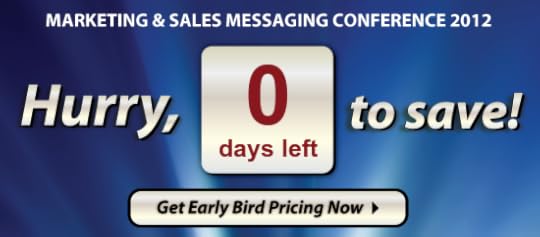Timothy Riesterer's Blog, page 31
July 23, 2012
Are you Buying Lottery Tickets to Get a Great Value Proposition?
“What’s the least painful approach to getting a great message for our salespeople?”
Make sure you read that quote again before moving on.
That’s what a senior marketing person at a major, multi-billion dollar company asked me yesterday. What I wanted to say was, “I want the same thing when it comes to getting in shape and losing weight.”
But seriously, ask yourself:
Do you believe that your value proposition is one of your most strategic assets?
When nearly everything about your products, services and programs is the same as your competitors, how important is the story you tell?
Does differentiation often come down to your message and how you deliver it?
My guess is that most of you said “yes” to all of those questions. If that’s true, why is everyone looking for shortcuts to a blockbuster, market-moving story? She went on to say… “We can’t spend two days in a room to work on that.” “We can’t expect to bring in people from the field to help shape our message.” “Our company can’t sustain that much heavy lifting just to get a pitch!”
How Much is Riding on that Message?
Well, how much did you invest in developing your products and services? What level of resources are you putting into your channel and go-to-market strategy? What revenue expectations do you have for this particular solution or initiative?
So, if the message is as critical as you say… and, your company is betting big dollars on the success of this launch… how much time and effort should you put into getting to your distinct point of view? One hour? A day? A couple days?
Do you need to break a sweat getting this thing right, and making sure it’s something that will be adopted and used in the field?
The Power of Compounding Interest
I received some great advice when I was starting my first job, and I think it applies in this situation. The CFO, who doubled as the head of HR, explained the value of maximizing my 401(k) contribution despite the fact that I was only making $15,000 a year in salary. He blustered on about how hard work, smart saving and the power of compounding interest would be the path to getting rich someday. I asked, “Are you sure, because I could really use that money to get air conditioning in my apartment.” He replied, “Son, lottery tickets are for losers.”
It took me a couple days to realize what he meant. But, that story came back to me today as I reflected on my conversation with that marketing executive. There are no get-rich quick schemes; they ultimately lead to failure and disappointment. The same can be said of your approach to creating value propositions that actually make a difference.
- Tim Riesterer
Chief Marketing and Strategy Officer
Corporate Visions
Filed under: Business-to-Business, Develop Messages that Matter, Distinct Point of View, Marketing, Message Creation Tagged: lottery, value proposition

July 17, 2012
Warming up a Cold Call with a Hot Opening
Here’s how the typical B2B cold call goes: “Hi, I’m so-and-so from XYZ Co., the leader in [insert undifferentiated and buzzword-filled boilerplate here]. I’d like to schedule a meeting with you to learn about your organization’s plans and challenges and discuss how our solution can help you optimize/leverage your [whatever].”
How successful are you with this approach? I’m guessing not very. Theoretically, this approach should work – you’re being consultative, wanting to learn all about the prospect so you can tailor your message to her specific requirements – but it doesn’t. Why?
Why Your Cold Calls Get the Cold Shoulder
Years ago there was a study done by AT&T that showed that, when you are cold calling, you’ve got 10 seconds to get a prospect’s attention from the time she says, “Hello.” By kicking off with your generic boilerplate and then requesting time so that you can ask questions to educate yourself about her company and then turn around and sell to her, you’ve given her something she’s heard a thousand times before and good reason to resent you for taking up her time.
Grabbing Their Attention
You need “Grabbers.” People are most attentive right out of the gate, so you’ve got to hit them with a hot opening – insights that would make it feel almost criminal not to engage in the next five minutes of conversation.
Grabbers break the pattern that your prospect is programmed to expect. They give the Old Brain something different than what it thinks is coming. Grabbers give you a way to break the pattern and create a hot and compelling opening along with spiking attention during your call.
Grabbers get your prospect emotionally involved and leaning into the conversation – they are the WOW of your message. Here are three types of Grabber techniques:
What-if-you questions
There are two common reactions by prospects when asked “what if you”: 1) excitement imagining the “what if you” scenario you’ve described, or 2) skepticism that the “what if you” is even possible. Either way your prospect is looking for how and proof, which translate into interest. Your Grabber did its job as a hot opening.
Number plays
You can prompt immediate attention by delivering numbers in an interesting story as part of your message. When you lay out a series of distinct and mysterious numbers and then tell a compelling story that brings those numbers to life, it will grab your prospect’s attention and linger in your prospect’s memory after you hang up the phone.
Customer stories with contrast
Sharing your customer stories well works for getting attention. Memorable stories can help your messages be remembered and be very persuasive. But you need to tell the story of your customers’ situations before they implemented your solution. It’s through the before story that your prospect will start to see her own company’s similar struggles and the need to consider doing something different.
By using Grabbers to heat up your call opener and punctuate the rest of your call, you can turn an ice cold call into a hot prospect. You’ve changed the customer conversation.
For more information on Grabbers or for examples of successful Grabber techniques, check out my book “Conversations that Win the Complex Sale.”
Filed under: Deliver Conversations that Win, Focus on your Prospect, Sales Tagged: cold call, contrast, customer stories, grabbers, number play, what if you

July 9, 2012
Sales Conversations Suffer from “False Starts”
When you start reading a new book, do you pick it up and flip right to the middle? How about when you watch a movie? Do you skip ahead rather than start from the beginning? My guess is, probably not. You would miss out on the set up of the story, who the main characters are and what makes them tick.
So why is it that most sales conversations start from the middle? What’s the “middle” when it comes to sales conversations, you ask?
Start From the very beginning – A very good place to start
Many salespeople immediately default to the “why us” conversation. This is where you go right to product features and benefits and what differentiates you from the competition. Similarly, most of their sales and marketing tools follow the same approach. (Think competitive matrix with all of your competitor’s names and their features and a bunch of full moons and half moons and quarter moons to show who wins the battle.)
Unfortunately, this method should be declared a “false start” because you have jumped the gun when it comes to how most prospects are looking at their first interactions with you and your company. According to research from Sales Benchmark Index, up to 60 percent of qualified leads end up in “no decision.” They stick with the status quo. Which means they were not ready to hear about “why you”… they really needed to hear about “why change?” and “why now?” But, your messaging and conversations started at question number three: “why you?”
More often than not, the companies you are talking to are not even engaged in a buying cycle, yet. They probably don’t even know whether they need your product or service. In fact, they may have the conversation with you simply to see if they even need to make a change at all. This is why you need to back up and start from the beginning.
Establish a buying vision
In order for your prospect to be ready to hear about “why you,” your messaging and conversations need to present a case for why change, why now. We call this – establishing a buying vision. This means challenging their current assumptions, helping them see how their current approach is being threatened, and highlighting the implications of not changing.
Next, you must identify a new set of needs and requirements or considerations. Finally, you must define a solution that aligns to your core strengths. This positions you as the most viable alternative when they move into the buying cycle. A recent Forrester study stated that 65 percent of executive buyers prefer to purchase from companies that first establish the buying vision. By creating the buying vision you can change the trajectory of the sales and buying cycle in your favor. But, you can’t just say that’s what you need to do. It requires a re-work of your messages, selling tools and skills training to ensure you have the ability to deliver a buying vision conversation.
Make the current customer status quo your competitor and “design point” for your messaging. Create executive whiteboard conversation tools that facilitate a consultative dialogue around how the status quo is no longer safe. And, train your salespeople to confidently demonstrate how your approach provides a contrasting new way, or new “safe” that directly addresses the most pressing challenges, threats, obligations and potential opportunities.
Filed under: Business-to-Business, Deliver Conversations that Win, Marketing, Sales Tagged: buying vision








July 3, 2012
Bring Your Message to Life – in 3D
“I’m a visual person.” How many times have you heard people say that? How many times have you said that yourself? The truth is most of us are “visual people.” Of the five senses, the Old Brain—the decision-making part of the brain – responds most strongly to the visual sense.
When you think visuals, you probably tend to think of imagery and infographics and video. But there is another type of visual that can also have a tremendous impact – a three-dimensional object. That’s right, a prop.
In fact, people use props all the time. If you’ve ever been at lunch and explained something to someone by moving glasses of water around to show how it works, you’ve used props. Here’s a perfect example from the movie The Blind Side.

The great thing about props is that they are memorable. But there is also a potentially bad thing about props – they are memorable. You should only use them to make an important point. If you don’t, you run the risk that they’ll seem silly or cute, and that’s not what you want. But do consider how you can use a prop to tell your story – and bring your sales message to life.
Props break the pattern of what’s expected.
It’s probably safe to say that no one looks forward to sitting in sales meetings. Most of them are predictable and, as a result, your prospects will have trouble focusing on your messaging and presentation. Using a prop creates the signal that this sales meeting will be different. And that makes it easy for your prospects to stay focused on what you are saying.
Props make a metaphor or analogy tangible.
Metaphors and analogies are great tools for helping people understand new or abstract concepts. Props can take your metaphor or analogy one step further to bring them to life. Consider the sales rep selling a payroll and benefits system to a midsize company. Her message was that the system enables you to run your business on truly valuable information, not “yesterday’s news.” Her prop was a copy of the Wall Street Journal. She noted that today’s issue was worth $2. Everyone in the room agreed that last week’s issue was not very valuable. Then she asked how much tomorrow’s issue would be worth if you could have it today? They got the connection. Instantly. The sales rep could have made the same argument in words, but having the physical copy of the newspaper drove the point home in a more memorable way.
Props create a physical reminder.
In another example, one sales rep was selling a sales lead management solution and his target prospect was typically the vice president of marketing who, he knew, spends a lot of time thinking about the sales funnel. This rep would bring a funnel to every sales meeting and use it as a prop to “illustrate” his message about how his solution improves the efficiency of the sales funnel. As he left the meeting, he would leave the physical funnel behind. Whenever he did a follow-up meeting, he’d always see the funnel somewhere in the prospect’s office. What’s the funnel doing for him the whole time he’s not in the room? It’s selling for him – reminding the VP why she needs his solution.
Consider your typical sales call, and see if you can’t up the “wow” of your message with a prop that brings your story to life.
Filed under: Business-to-Business, Deliver Conversations that Win, Props, Sales Tagged: The Blind Side, visual








June 27, 2012
Demand Gen Deficit
Every quarter we survey more than 440 marketing and sales professionals who work in complex, business-to-business selling environments. This round, we focused on messaging for demand generation. Here’s what we found:
80% of marketing and sales professionals aren’t completely confident in the effectiveness of their demand generation campaigns.
The #1 problem is that demand gen content isn’t compelling or provocative enough.
60% respondents say that their company’s demand gen content is focused on their company’s products/features, instead of customer’s pain points.
Filed under: Business-to-Business, Develop Messages that Matter, Marketing, Message Creation Tagged: Campaigns, demand generation








June 18, 2012
Who in Your Organization has Their Fingerprints on the Gun?
It is 8:00 a.m., day two of your annual sales meeting. Product marketing is up first. A tall pedestal sits next to the podium draped in a black cloth. Out walks Joe, the director of product marketing in the hardware division – dressed in his nicely pressed shirt adorned with the company logo and so excited to share his news. He begins his presentation. He welcomes everyone, updates you on the state of the market and – “ta da” – he pulls off the black cloth and introduces you to the newest addition to the product family. He then begins to share the elevator pitch and features/benefit messaging. And, finally he concludes with a list of marketing tools that he and his team have been diligently working on over the past several months to help the sales organization sell this new product into their accounts.
Does this scenario sound familiar? Probably. It is pretty typical in most organizations. Product management and product marketing work together to develop and bring to market their individual products. They have a standardized checklist of launch deliverables that they churn out prior to the big reveal. But what about the other product teams? How does this product fit into the larger product portfolio? And, what about the sales team? How will this product fix the problems that their customers need to solve? Do the product teams even know what those problems are? How much of the messaging and tools will actually work the way real customer conversations work?
Avoid the “ta da” method – get others involved
In the example described above, there was a lot of upstream planning with little input from key stakeholders across the value chain, in particular the people who actually conduct the conversations that matter. By bringing in downstream players, specifically representatives from the sales team, you benefit in two important ways. First, they bring with them the perspective of the customer. They are talking to prospective and current customers every day. They are the feet on the street and bring to light the real-life problems that customers are looking to solve. Second, they are the people that will choose to use – or not use – the tools that the product teams work so hard to develop.
Develop the message together
If sales and marketing are aligned from the outset, together they can develop a relevant and impactful story, right from the start. One key is making sure the messaging passes the “snicker” test – can a salesperson actually say this without snickering. This cross-functional story building effort can then be cascaded throughout meaningful tools and support materials that will help bring it to life. Finally, with this elevated level of joint collaboration, it no longer becomes about “us” and “them.” It’s no longer about the sales team sitting in a dim room waiting for the big “ta da” – everyone is connected to the story. Everyone has his or her “fingerprints on the gun.” This ownership will breed passion and that passion will close the sale.
Filed under: Business-to-Business, Develop Messages that Matter, Marketing, Message Creation, Power Positions & Differentiation








June 14, 2012
Get to the Gut of CEO Decision-Making

See Larger View (opens in a new window)
You’ve probably heard one of Henry Ford’s best quotes, “If I had asked the people what they wanted, they would have said faster horses.” CEO.com recently published an infographic on why great CEOs often rely on their ‘gut’ instead of voice-of-the-customer research and market data to make their most game-changing decisions.
Here’s why this infographic matters to you.
Marketers, Your Customers are Probably Wrong
The New Coke story is a classic example of the danger of weighting what your customers think they need (“Yes, this tastes good”) over their subconscious emotional anchors (But it’s just not Coke).
Your prospects are firmly, emotionally anchored in their status quo. They don’t know what they need to do to take their organization to the next level… so don’t ask them. Tell them. The burden of proof of why they need to do something different rests squarely on your shoulders. Come to your prospects armed with new insight (something they didn’t know about a problem they didn’t even know they had), wrapped in the context of why it’s going to be deeply painful if they don’t move quickly.
Salespeople, Bewitch the Old Brain
Executive personality types can’t be seduced by data dumps. They make decisions with their gut — their overall impression of you, their judgement on whether your company will prove to be a strategic partner to them, and the value of your product. Then, if necessary, they’ll justify that decision with facts. So if you want to message for a decision, you need to get past the gatekeeper of their neocortex (which analyzes your data) and appeal to their Old Brain, which makes the impulse call. Techniques taught in Power Messaging like creating contrast, setting context, and Big Pictures are meant to stimulate their instincts and win their ‘gut’ over.
Attend the Marketing and Sales Messaging Conference
Creating and delivering insightful, compelling messaging that drives for a decision is the entire focus of the 2012 Marketing and Sales Messaging Conference. This event is your opportunity to tap into the experience of companies like Wells Fargo, Lawson Software and Centurylink, as well as get inspired from keynote speakers Billy Beane (of Moneyball) and Ben Zander (Conductor of the Boston Philharmonic Orchestra).
The conference is filling up at 4X the pace of last year… so sign up now, and bring your colleagues. And to create some urgency for your Old Brain…here’s how much time you have left to register to get early bird pricing of $399.
http://conference.corporatevisions.com
Filed under: Big Picture, Business-to-Business, Deliver Conversations that Win, Marketing, Message Creation, NLP, Sales, Your Buyer's Mind Tagged: b2b marketing, b2b sales, CEO, CEO.com, context, contrast, decisions, gut instinct, Infographic, Marketing and Sales Messaging Conference, Old Brain, Power Messaging, voice of the customer








May 31, 2012
Are you igniting sales-ready leads, or just hand-raisers?
More than 60% of marketers say their greatest challenge is generating more leads (Forbes).
The problem is, when prospects see your messaging, they only find 10% relevant to them (CEB & IDC).
Demand generation is about creating sales-ready leads, but your messages sound like everyone else’s.
And, *ahem*, your content is boring.
You need to show your prospects that their status quo is unsafe. Are your campaigns creating urgency, or are you creating ineffective content?
Watch this video to learn more:
Filed under: Develop Messages that Matter, Marketing, Message Creation Tagged: demand generation, Leads








May 18, 2012
Are You a Confuser or Clarifier?

A couple of quotes from really smart people crossed my desk recently. They highlight a core challenge sales and marketing people need to solve with the messages they create and deliver. Here they are:
“While our access to raw information has grown exponentially, our time to process this information has declined rapidly, which has placed an unprecedented premium on the act of meaning-making.” (George Dyson, Futurist)
“People are information-rich and theory-poor. If you can give them a way of organizing their experience, then their minds are wide open.” (Malcolm Gladwell, Author)
So, the question for you is… Are you a meaning-maker? Do you turn information into theory?
Test yourself, are you a confuser or a clarifier:
Confusers pile information on their prospects and customers assuming that more is better. Clarifiers cut through the clutter and make sense of the data to present usable insights.
Confusers use lots of industry jargon because they assume their prospects and customers like the lingo and it adds credibility. Clarifiers know better and instead use simple, concrete terms along with metaphors and analogies to make sure their audience understands.
Confusers ask lots of questions, expecting their prospects and customers to blurt profound pains and answers they are looking for. Clarifiers know their audience is wondering if they need to change and are looking for relevant, unique ideas on why they should do something different.
Confusers use lots of words in their campaigns, communications tools and presentations. Clarifiers tell engaging stories and use lots of visual support including hand drawings and infographics.
This is especially important for your marketing lead generation efforts. Brain science research proves that people respond better to emotional, visual and spoken-word messaging, yet most B2B demand generation still relies heavily on volumes of written content like whitepapers. Talk about being a confuser. If you want to engage prospects and disrupt their current status quo you have to do better. Check out this video to learn about a new visual storytelling approach for your lead generation programs.
Do you have a confuser vs. clarifier example?
Share it with us and we’ll post it so others can test themselves and their messaging.
Filed under: Business-to-Business, Marketing, Sales Tagged: B2B, business-to-business, customer conversation, demand creation, demand generation, lead generation, marketing, marketing messages, sales, sales messaging








April 16, 2012
Do You Smell Smoke?
Corporate Visions’ CEO, Joe Terry, recently spoke at Forrester’s Technology Sales Enablement Forum. He held up a brand new iPad 3 and said, “I stood in line, in the rain, for three hours on Friday to get this. It’s got a Retina display. A 5MP iSight camera. And 4G LTE. Who wants it?”
Several people raised their hands.
“No really, who wants it?”
The hands started waving around a bit.
“Come on now. Who wants a free iPad?”
Finally, someone (who had seen Joe do this trick before) stood up, ran up front, and yanked it out of his hands.
“That’s what I’m talking about. I’m trying to give you one of the hottest pieces of technology on the market — for free. And only one of you out of a room full of people was willing to break the mold and take action.
“Do you see how powerful the status quo is? How hard it is to get people to step outside of their comfort zones and do something different? Even when the value and benefits of doing it are so clear?
“Now, what if I told you that I smelled something… in fact, I think I smelled smoke? What if I told you that this building was on fire? And that the fire was going to get to this room in three minutes? But fortunately, I had been trained by the hotel on the best route to safety, so you should line up behind me.
“I bet you’d stand up and take action, wouldn’t you? And if some guy was standing in the back of the room saying, ‘Who wants a free iPad?’, who would you listen to… me, or him? Me, obviously.
“Once we were safely outside, let’s say I held up an iPad again. And the guy from the back of the room was there as well and held up his iPad. Who would you accept the iPad from? Me — because now you trust me. I was the one who told you about the threat and led you to safety.”
There’s a time and a place for extolling your products’ features, value propositions and fantastic ROI. But first, you have to get your prospects’ attention by identifying and amplifying the challenging context surrounding their status quo approach — context that creates urgency to do something different. Bring advanced insight to your prospects… help them smell and see the smoke. That a threat to their desired business outcomes is coming, and it’s coming fast. Then, and only then, have you earned the right to lead them to the safety and value of your solution.
Get your prospects to see and smell the smoke!
Attend this free 90-minute virtual preview of a new, advanced Power Messaging workshop from Corporate Visions, Power Deal Creation. You’ll learn how to proactively deliver a “distinct point of view” that loosens the status quo and provokes your prospects to do something different. By attending, you’ll get a chance to win a free pilot or two free passes to the Marketing and Sales Messaging Conference for your company!
April 23, 2012 – 11:00 AM PST
REGISTER >>
Filed under: Uncatergorized Tagged: context, Fire, iPad, Joe Terry, Smoke, Urgency








Timothy Riesterer's Blog
- Timothy Riesterer's profile
- 3 followers









